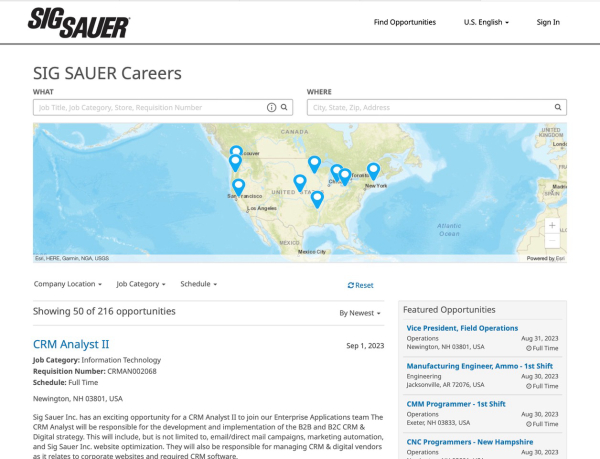During one of my infrequent catch-up calls with Tom Taylor, SIG Sauer’s Chief Marketing Officer and Executive Vice President, Commercial Sales, I learned that all the success the company’s enjoyed by winning military contracts and producing guns the “rest of us” like, isn’t without its accompanying challenges. From physical expansion to hiring workers to produce product in that space, there’s lots happening at SIG.
The company’s newest contract- the U.S. Army’s Next Generation Squad Weapon (NGSW)- will cement SIG’s position among the elite of the nation’s small arm suppliers. It also means significantly ramping up of the company’s physical facilities and head count.
SIG is moving on both fronts. Eventually, Taylor tells me, SIG will grow from today’s approximately one million square feet of manufacturing and storage to “around 1.6-1.8 million square feet” over the next 3-5 years.
That, is a lot of growth. The land has been secured and the first phases of development are underway.

OWDN photo
SIG CEO Ron Cohen proudly showed off SIG’s Next Generation Squad Weapon (NGSW) at the original SIG Freedom Day in May of 2022 at Ben Avery Shooting Center outside Phoenix, Arizona. Since then, the NGSW has gained plenty of admirers in military units worldwide.
Space, however, isn’t as challenging as adding new employees to put those new spaces to work.
Despite what Taylor calls “amazing” advances in SIG’s manufacturing technology, including robotics that enable a single worker to manage as two four-axes CNC machines (it used to be one operator per single axis CNC unit), SIG needs more people. Lots more people.
If you’re a business owner, you know the manpower issue is a challenge.

A screenshot from SIG’s website shows potential employees the company’s features, benefits, and locations. There’s something there for virtually anyone.
Across the country, regardless of business category, employers are finding it increasingly more difficult to find, recruit, and hire workers, trained or otherwise.
SIG is located in New Hampshire, the state with the lowest rate of unemployment in the country. That’s an additional challenge for a company that says it will need “at least 600, and likely 800-1,000 new employees” over the next 18-24 months.
For SIG, it’s “problematic” to the point the company now has an entire staff unit dedicated to recruiting.
“It’s not an issue as far as fulfilling our existing contracts,” Taylor told me, “but we’re regularly landing new ones- and the appetite for our military and law enforcement products is growing - worldwide.”
Sounds like what a business friend of mine once described as a “blessed problem.” And it’s not a challenge unique to SIG. Any company looking at expansion knows it’s a challenging time.
Recruiting, hiring and keeping good people is handicapped by a number of factors today. Not the least of which is governmental benefits for unemployment that have significantly impacted lower-paying service industry jobs.
Then there are “quiet” issues many employers and executive recruiters are loathe to even discuss.
Last week, the New York Sun published a story entitled “Why Some Employers Are Wary of Hiring People Who List ‘Pronouns” on Resumes”. The story cites a number of studies, including two by business.com and McKinsey, that say (quietly) that “social issues” like personal pronouns- are some reasons potentially qualified applicants don’t get contacted by human resource offices.
According to that report, it’s an “open secret” in more liberal areas (using San Francisco’s “Bay Area” as the example) that business owners no longer want to interview, much less hire, applicants with “they/them” pronouns on their resumes.
The reasoning? “Too much narcissism, not enough maturity and very unreliable.” Even “classic, bleeding heart liberals” the report says, are tired of “acquiescing to so many of their demands and the amount of drama they cause in the workplace” to the point “their patience has just ended.”
If you’re a business owner and that resonates with you, take some consolation in the fact you’re not alone. Across the country, the challenge of finding, then keeping qualified applicants remains an issue.
Since the government’s mandated shutdowns over COVID, things have changed in employer/employee relationships. Originally hailed as a bright new day for business -remote work- has already lost much of its luster across corporate America, especially for employers.
It was never much of a “thing” in manufacturing, because making things requires both presence and participation. If you’re not on those jobs, either someone else does them, or it doesn’t get done. The majority of companies in the outdoor industry learned to adapt out of necessity. Consequently, at all but upper management positions, remote work remains a non-starter.
Many internal factors impact corporate growth, from an absence of innovation or loss of customer focus to the lack of working capital, or simple bad management. All those are relatively simple to address.
A manpower shortage, however, is not a simple fix. That’s why SIG has created a recruitment department.
According to the U.S. Chamber of Commerce, it’s not a perceived issue; it’s real. Workforce participation today, compared to pre-pandemic levels in February of 2020 shows there are 1.9 fewer Americans working today than then. At the height of the pandemic, the Chamber says 120,000 businesses temporarily closed. When that happened, more than three million adults were essentially forced into early retirement. Adults 55 and older who left the workforce grew from 48.1% in Q3 of 2019 to 50.3% in Q3 of 2021.
Further, the Chamber says, “if every unemployed person with experience in the durable goods manufacturing industry were employed, the industry would only fill 75% of the vacant jobs.” As of March 2023 (the latest Chamber numbers), there are an estimated 639,000 vacant manufacturing jobs.
With somewhere between 600 and 1,000 new slots opening at SIG, it would seem a good time for young adults with an interest in the firearms industry to start looking -seriously- at job opportunities that are literally looking for them.
SIG, being SIG, has turned its attention to the challenge. Based on what they’ve accomplished to this point, it looks like New Hampshire’s unemployment rate will be headed even lower soon.
We’ll keep you posted.
— Jim Shepherd